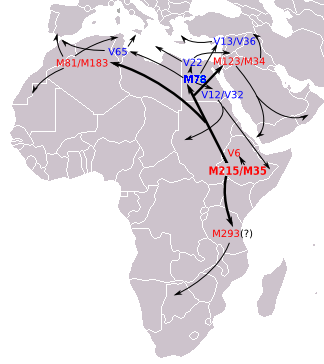This year, Ugandans have witnessed the use of DNA tests to settle prominent public cases in the media concerning the paternity of children and of celebrities who have died. What has not been known to many people is the dispute concerning the ethnicity of the ancient Egyptians by scholars in the 20th Century. This dispute has been solved scientifically by the DNA tests conducted on the mummies of the ancient Egyptians in 2012 and 2013.
In December 2012, DNA tests were conducted on the mummies of Pharaoh Rameses III and his son, which proved that they belonged to human Y chromosome group E1b1a. This is the Y chromosome group of Sub Saharan Africans who speak Niger–Congo languages.
The disclosed Y chromosome group of the Pharaoh, at the time of releasing the report, was considered as just one of the details to make the investigation scientifically solid with facts. But its revelation caused a stir equal to the purpose of the original forensic investigation.
Another group of mummies from the Amarna period of Egyptian pharaohs were tested by DNA Tribes, an American Company which specialises in conducting DNA tests, in 2013.
The conclusion of the tests were that the mummies autosomal profiles would be most frequent in the present day populations of the African Great Lakes region and Southern Africa. Subsequent analysis of the autosomal profile of the mummy of Pharaoh Rameses III also concluded that this matched the genetic profiles of the population of the Great Lakes region as well.
It was reported in the DNA Tribe’s digest of February 2013, that the DNA match results of the ancient Egyptian Amarna royal mummies with the present day world regions reflect the population changes in Africa after the time of Rameses III .
One issue which remains unresolved is that of language. The language of ancient Egypt is classified as belonging to the Afro-Asiatic family of languages, which are spoken by people like the Somali and Amhara of Ethiopia, while the genetic profiles of the mummies match those of Niger–Congo language speakers. The most likely explanation is that some of the Niger-Congo speaking people, who were carriers of human Y chromosome E1b1a, moved into ancient Egypt along the Nile from the Sahara region as the region dried up and fused with the Afro-Asiatic speaking people, giving rise to the unique language of ancient Egypt.
However, these speakers of the Niger–Congo language went on to form the ruling class producing pharaohs for Egypt, while retaining the customs which they practiced in common with their relatives who had migrated south into the Great Lakes region as the genetic tests have shown.
THE CONNECTIONS
The strong cultural connection between the ancient Egyptians and the modern people of the Great Lakes region of Africa have long been noted for more than a century now by ethnographers (people who study ethnicity). The following examples illustrate this connection.
Female heirs. The Egyptian pharaohs, like the rulers of the Great Lakes kingdoms of East Africa, ascended to their thrones with their sisters or cousins as co-rulers. In Bunyoro and Tooro kingdoms, the sister was called the Rubuga, but is currently called the Batebe. In Buganda kingdom, she was called the Lubuga, now called Nalinya. In Buganda, this custom from antiquity of having female co-heirs is still practiced in all cultural succession events.
Royal drums. Secondly, in all the Great Lakes kingdoms, ceremonies were carried out at certain intervals to welcome the appearance of the new moon. Regalia such as the royal drums and twin objects were brought out on these occasions to pray for the wellbeing of the kingdoms as was done in the courts of the ancient Egyptian pharaohs.
Bows and arrows. Another custom of the pharaohs in common with the kings of Great Lakes kingdoms were the use of bows and arrows in the coronation ceremonies. The coronation rituals of the pharaohs were repeated in the Sed festivals of the pharaohs, a record of which has been kept by historians. A description of the bow and arrow part of the coronation section reads: “Next, the pharaoh was carried to the chapels of the gods Horus and Seth, where he was handed a bow and arrows with which he shot an arrow in each of the four directions” i.e. East, West, North and South.
In Bunyoro. An identical ceremony was enacted during the coronation of the Omukama of Bunyoro Kingdom. In his book: Abakama Ba Bunyoro Kitara, published in 1947, John William Nyakatura, a historian and a county chief of Bunyoro Kingdom, recorded the following ceremony for the new king: “Then the king was handed bows and arrows. He shot four arrows in all directions- one arrow was shot in the direction where the sun rises (Buganda and Busoga), the second one was shot in the direction where the sun sets, the third one in the southward direction (Nkore and Rwanda), the fourth one was shot in the northward direction (Bukedi and other countries). This action meant every rebel/rival who came from any of these directions would be killed with an arrow.
In Buganda. Buganda Kingdom in precolonial times also had a bow and arrow coronation ceremony as part and parcel of the enthronement rituals of the kings. In fact, the one of Buganda was deadly. A captive would be shot with an arrow by the new Kabaka to indicate that he would be vigorous in protecting his kingdom. The victim would then be killed by the king’s guards thereafter.
Musical instruments. The similarities between ancient Egypt and the Great Lakes also extended to the material culture. Scholars have noted the resemblance of the musical instrument in ancient Egypt and the kingdoms of the Great Lakes, notably the bow- harps and flutes. This fact is mentioned in the display of Ugandan bow harps at the Uganda Museum.
The plank sewn canoes on Lake Victoria used in precolonial times were bound together using vegetative materials and were assembled in a similar way to the boats used by the ancient Egyptians on the Nile. This similarity was noticed by the scholars when British rule was established in East Africa.
Civilization. In the 19th Century, explorers and anthropologists encountered the Great Lakes kingdoms and noted the unexpected sophistication of the societies in these kingdoms. It was assumed that Egyptian culture had influenced the culture of the Great Lakes region. In the actual fact, the direction of influence was the other way round. The anthropologists were observing a society similar to one out of which the ancient Egyptian civilization had emerged.
Again these just jat prove that ancient egyptian were multiracial .
WHERE IS THE SOURCE, BREH?








